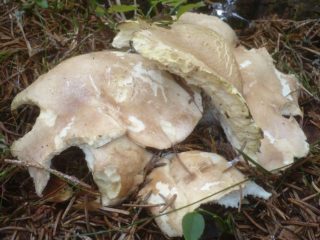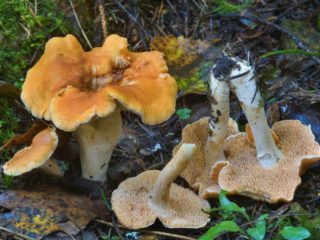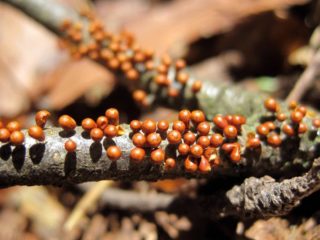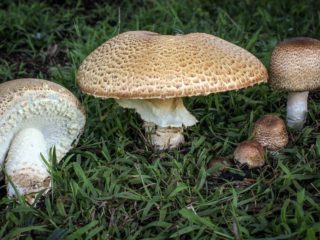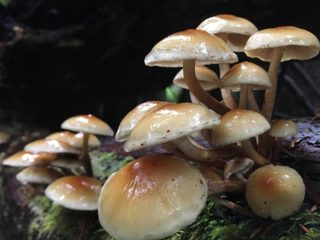Content
Albatrellus caeruleoporus is a species of tinder fungus from the Albatrellaceae family. Belongs to the genus Albatrellus. Being saprophytes, these fungi process woody remains into fertile humus.
Where does albatrellus grow?
Albatrellus blueporus is common in Japan and North America; it is not found in Russia. Loves coniferous and mixed, pine-deciduous forests. Settles in dead wood, under tree canopies, in forest clearings, in large groups. If mushrooms grow on a steep slope or vertically standing substrate, they are arranged in tiers. Often they form single organisms fused with legs, consisting of a dozen or more fruiting bodies on a fleshy stem.Very rarely grow alone.
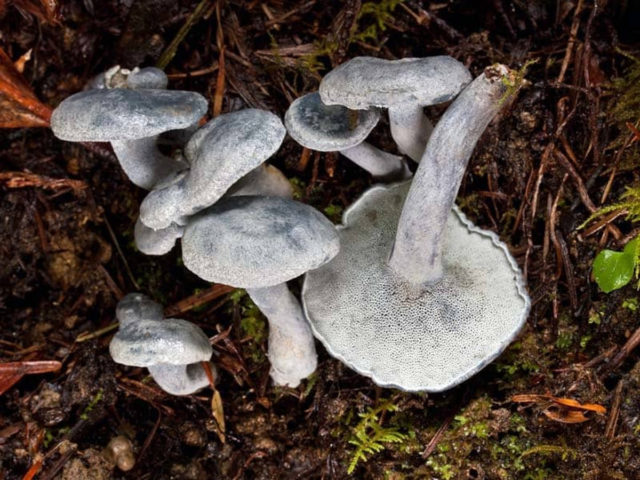
Albatrellus blueporus grows in groups of 5 or more fruiting bodies
What does blue-pore albatrellus look like?
The cap of young mushrooms is smooth, spherical in shape, with rounded edges rolled downwards. It can be flat or have 1-2 folds. As the cap grows, it becomes umbrella-shaped and then spread out disc-shaped, slightly concave in the central part. The edges remain folded down. Smooth, sometimes jagged-wavy and folded. The surface is dry, rough in drought, with small scales. Grayish-blue when young, then fades and darkens to ash gray with a brown or reddish tint. Diameter from 0.5 to 6-7 cm.
The surface of the inner spongy layer is gray-blue in color, the pores are angular and of medium size. Dried mushrooms take on a rich ash or red color.
The pulp is thin, up to 0.9 cm thick, elastic-dense in the wet period, reminiscent of hard cheese in consistency, and becomes woody in drought. Color ranges from white-cream to light ocher and red-orange.
The leg is fleshy, can be cylindrical, curved, thickening towards the root, or tuberous with irregular shape. Color ranges from snow-white and blue to grayish and ash-violet. Length can vary from 0.6 to 14 cm and from 0.3 to 20 cm in diameter. At places of damage or cracks, brownish-reddish flesh appears.
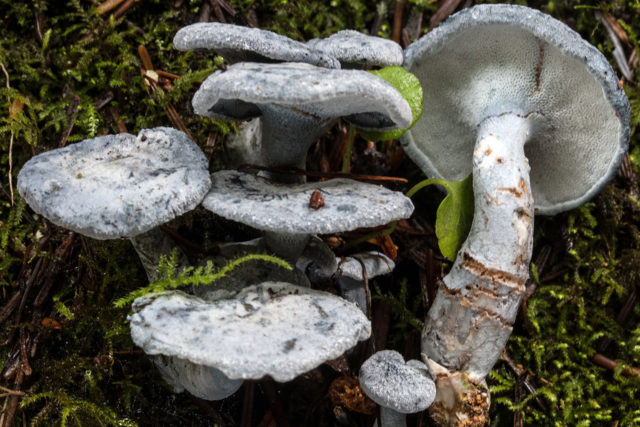
The hymenophore is fused with the stalk, sometimes descending along it up to half its length
Is it possible to eat albatrellus sineporata?
Albatrellus blueporus is classified as conditionally edible. Does not contain hazardous or toxic substances. Accurate data on nutritional value and chemical composition are not publicly available.
Taste qualities of mushroom
Albatrellus blueporus has dense, elastic flesh with an indistinct odor and a soft, slightly sweet taste.
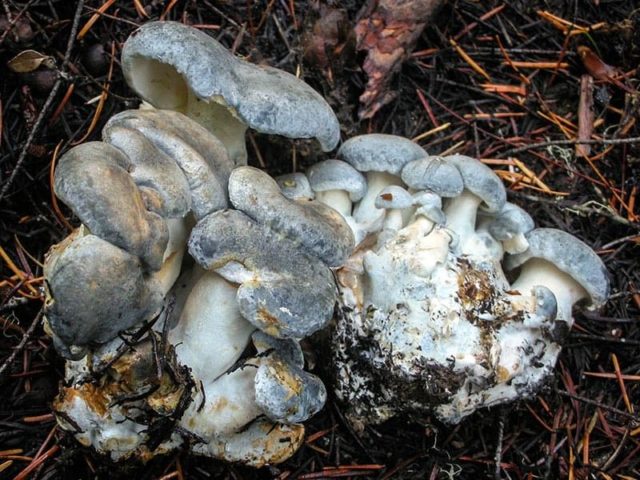
Albatrellus blueporus often has many caps on one large, irregularly shaped stalk.
False doubles
Albatrellus bluegrass is very similar in appearance to its mountain brother, Albatrellus flettii (violet). Delicious edible mushroom. It has brown-orange irregularly rounded spots on the caps. The surface of the hymenophore is white.
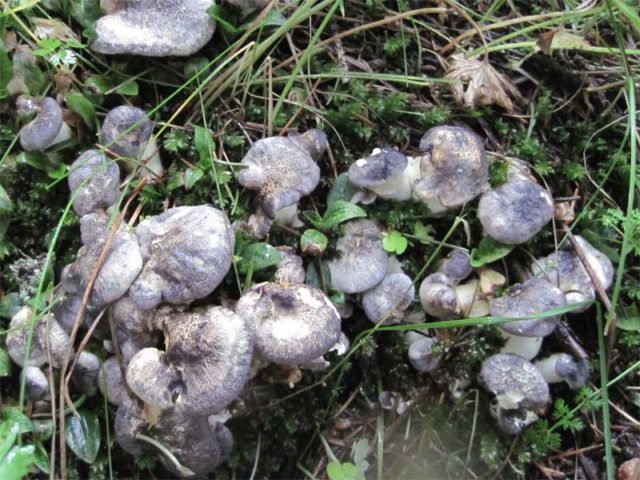
Grows on rocks, forming mycorrhizae with conifers.
Collection and use
Albatrellus blueporus can be collected from June to November. Young, not overgrown or woody specimens are suitable for food. Carefully cut off the found fruiting bodies with a knife at the root or remove them from the nest in a circular motion so as not to damage the mycelium.
Useful properties of the mushroom:
- relieves joint inflammation;
- normalizes blood pressure and cholesterol levels;
- increases immunity and resistance to aging processes;
- promotes active hair growth, has a diuretic effect.
In cooking it can be used dried, boiled, fried, pickled.
The collected fruiting bodies should be sorted out and cleaned of forest debris and substrate. Cut large specimens.Rinse well, add salted water and cook over low heat, skimming off the foam, for 20-30 minutes. Drain the broth, after which the mushrooms are ready for further processing.
Meat rolls with mushrooms and cheese
Albatrellus sineporosa makes amazingly delicious baked rolls.
Required ingredients:
- chicken and turkey fillet – 1 kg;
- mushrooms – 0.5 kg;
- onion – 150 g;
- hard cheese – 250 g;
- any oil – 20 g;
- salt – 10 g;
- pepper, herbs to taste.
Cooking method:
- Rinse the meat, cut into strips, beat, sprinkle with salt and spices.
- Cut the mushrooms into medium pieces, grate the cheese coarsely.
- Peel the onion, rinse, cut into strips.
- Place mushrooms and onions in a hot frying pan with butter and fry until golden brown.
- Place the filling on the fillet, sprinkle with cheese, wrap in a roll, and secure with thread or skewers.
- Fry on both sides in a frying pan until crusty, place on a baking sheet and bake for 30-40 minutes at 180 degrees.
Cut the finished rolls into portions and serve with herbs, tomato sauce, and sour cream.
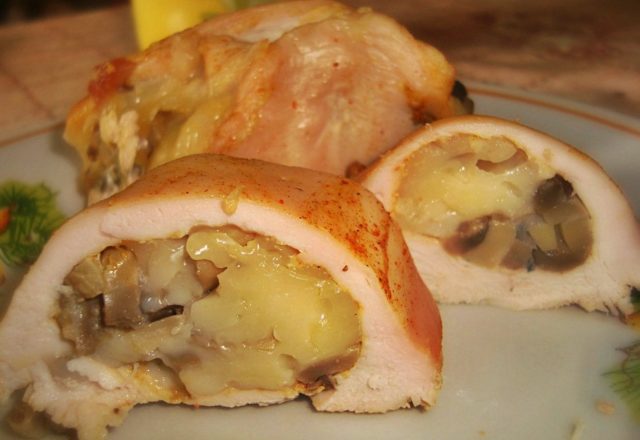
Appetizing rolls can also be served on a festive table
Conclusion
Albatrellus blueporus is a saprophytic mushroom belonging to the group of tinder fungi. It is not found in Russia; it grows in Japan and North America. It settles in coniferous, less often mixed forests, on soil rich in woody debris and rotting branches, often hiding in moss. Edible, has no poisonous counterparts. The only similar mushroom grows in rocky areas and is called Albatrellus fletta. There is no exact data on its nutritional value, but the mushroom is used in cooking.

